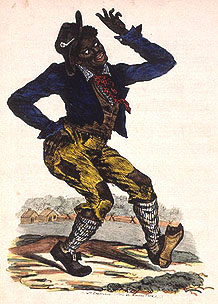
The term "
Jim Crow" was originally taken from a character performed in blackface by Thomas Rice, a pre-Civil War white actor who dressed in rags to portray a shabbily dressed, rural black man.
Last week I was invited to give a talk about free speech at Ferris State University in Michigan. Much to my pleasure, I discovered that one of the professors at Ferris is an old colleague, Dennis Ruzicka, who was a fellow reporter 20 years ago when we both worked for a small-town, daily newspaper in Wisconsin.
After the talk, Dennis showed me around the campus. One of our most fascinating stops was the "Jim Crow Museum of Racist Memorabilia" that has been assembled by sociology professor David Pilgrim. The Jim Crow Museum contains more than 2,000 racist artifacts, dating from pre-Civil War days to the present: cartoons, Sambo masks, Coon toys, Picaninny ashtrays, Ku Klux Klan literature, postcards with Black children portrayed as "alligator bait."
"All racial groups have been caricatured in this country, but none have been caricatured as often or in as many ways as have black Americans," Pilgrim writes. "Blacks have been portrayed in popular culture as pitiable exotics, cannibalistic savages, hypersexual deviants, childlike buffoons, obedient servants, self-loathing victims, and menaces to society. These anti-black depictions were routinely manifested in or on material objects: ashtrays, drinking glasses, banks, games, fishing lures, detergent boxes, and other everyday items. These objects, with racist representations, both reflected and shaped attitudes towards African Americans. Robbin Henderson, director of the Berkeley Art Center, said, 'derogatory imagery enables people to absorb stereotypes; which in turn allows them to ignore and condone injustice, discrimination, segregation, and racism.' She was right. Racist imagery is propaganda and that propaganda was used to support Jim Crow laws and customs."


 Since then, it's gotten little media attention -- just 41 mentions in U.S. newspapers and wire stories, according to a news database search on October 11. That's remarkably sparse coverage for a story showing that the U.S. government has been engaged in illegal
Since then, it's gotten little media attention -- just 41 mentions in U.S. newspapers and wire stories, according to a news database search on October 11. That's remarkably sparse coverage for a story showing that the U.S. government has been engaged in illegal 
